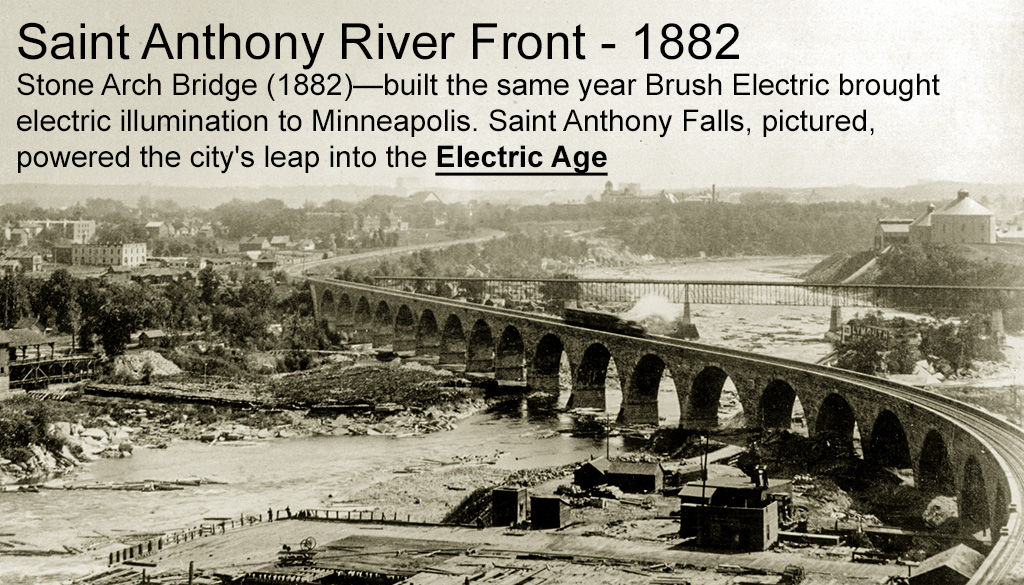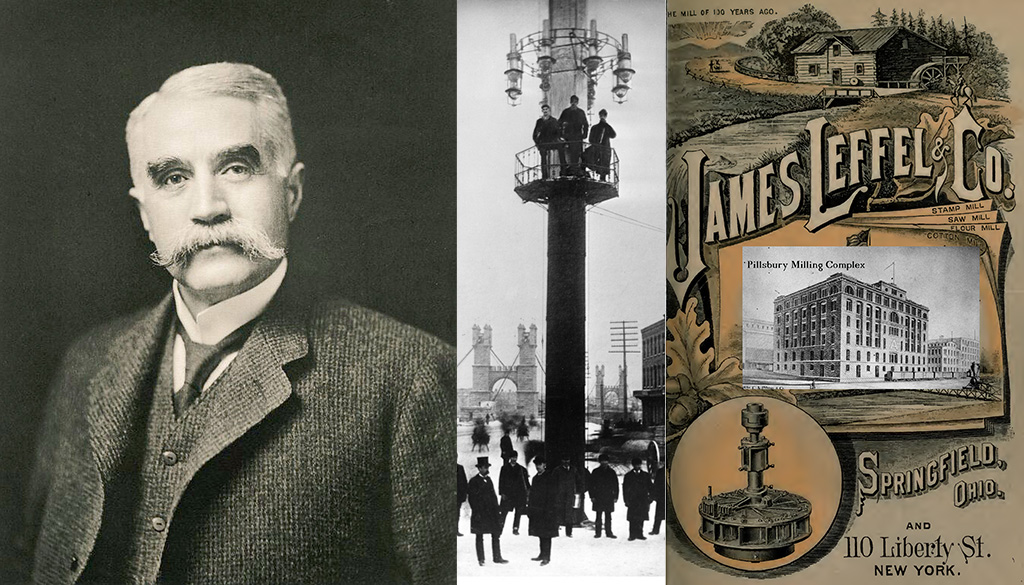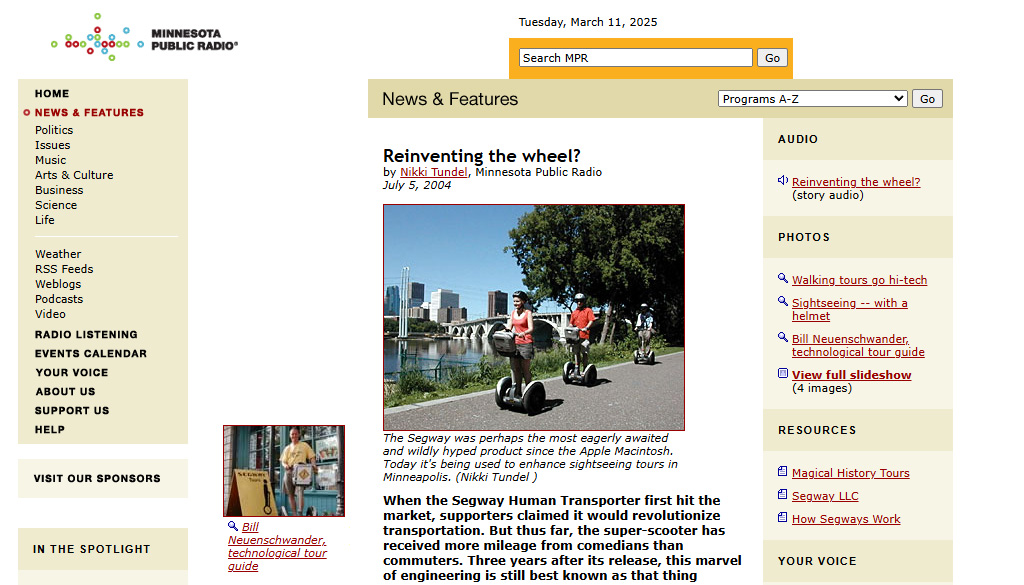Minneapolis – Village of Saint Anthony
March 11, 2025
The Confluence of Hydroelectric History and Modern Green Innovation: Saint Anthony Falls from 1882 to Greenev.com The intertwined histories of technological innovation and environmental stewardship converge dramatically at Saint Anthony Falls in Minneapolis.
March 11, 2025, marks a significant milestone for GreenEV.com and its parent company, Mobile Entertainment LLC of Minnesota. For 20 years, GreenEV has been at the forefront of sustainable transportation, proudly operating the world’s first fleet of electric vehicles (EVs) exclusively charged with 100% renewable energy through Xcel Energy’s Green-E Certified Windsource® program.
Since its inception in 2005, GreenEV has demonstrated an unwavering commitment to environmental stewardship by utilizing Green-e® Energy Certified renewable power for its operations. This pioneering approach not only set a precedent in the EV industry but also showcased the viability and cost-effectiveness of renewables long before they became mainstream.
Bill Neuenschwander, founder of HumanOnAStick Segway Tours and visionary behind GreenEV, reflects on the journey: “Segways are incredibly efficient, and the cost of renewables was easy to justify then and now. The story is simple sustainability works.”
History of Saint Anthony Falls & HumanOnaStick fleet of Segways (EV’s)
Proximity to important history frequently inspires more history, if the person being inspired connects the importance of time and place. Minneapolis – has had the DNA of innovation and community betterment as a collective
Bill Neuenschwander – March 11 – 2025
The intertwined histories of technological innovation and environmental stewardship converge dramatically at Saint Anthony Falls in Minneapolis. This report examines two pivotal moments separated by over a century yet connected through hydroelectric legacy: the 1882 operations of the Saint Anthony Falls Brush and Electric Company, and entrepreneur Bill Neuenschwander’s 2004 epiphany at St. Anthony Main that led to Greenev.com’s renewable energy solutions for electric vehicles. Through archival records and contemporary accounts, we trace how the falls’ hydraulic power first electrified a city in the Gilded Age before enabling 21st-century sustainable transportation, revealing an unbroken thread of energy innovation spanning 123 years.
Historical Foundations: The 1882 Saint Anthony Falls Brush and Electric Company – The Hydroelectric Context of Minneapolis Saint Anthony Falls’ 50-foot drop on the Mississippi River provided unmatched potential for mechanical power generation, with sawmills dominating its early industrial use. The 1878 introduction of Charles F. Brush’s arc lighting system created a new demand for centralized electrical generation, culminating in the 1882 establishment of the Brush Electric Light Company’s powerhouse at the falls. Unlike Thomas Edison’s later incandescent systems, Brush’s DC dynamos powered streetlights and factory motors through direct hydro mechanical coupling – waterwheel shafts connected to electromagnetic generators without intermediate steam conversion.

In 1882, Minnesota Brush Electric Company built its first power station on Upton Island, just below St. Anthony Falls in the Mississippi River. The company leased the land on Upton Island from Minneapolis businessman Dorilus Morrison. It also secured a water grant from the Minneapolis Mill, of which Morrison was president, and leased water rights from others. As a result, the company could pull power directly from the falls.
Technical Specifications and Urban Impact
Archaeological studies of the 1882 powerhouse foundations reveal two 12-foot diameter Leffel turbines producing 175 horsepower each, driving Brush No. 6 dynamos rated at 110 volts/800 amps. This 176 kW capacity illuminated 62 arc lamps along Minneapolis’ Washington Avenue, creating North America’s first fully electric-lit commercial district.

Contemporary newspapers noted the system’s limitations—power transmission was capped at 1 mile due to line losses and dangerously exposed conductors—but recognized its symbolic importance as “the Niagara of the West electrifying civilization’s frontier.”
Economic and Regulatory Landscape
The Minnesota State Legislature’s 1881 “Act to Encourage Manufacturing” (Chapter 148) provided tax incentives for industries using falls-generated power, leading to Brush Electric’s $315,000 investment (equivalent to $9.8 million today). Rate schedules preserved in the Hennepin County Archives show commercial subscribers paid $1.25 per arc lamp per night. At the same time, residential service remained prohibitively expensive at $4.50 weekly – confining early electric access to businesses. This economic model inadvertently shaped Minneapolis’ industrial geography, with electrified flour mills and lumber yards clustering near the falls while residential areas retained gas lighting until AC systems arrived in 1886.
The Human Stick Catalyst: 2004 St. Anthony Main Revival
Post-Industrial Redevelopment Context
By 2000, the historic milling district adjacent to Saint Anthony Falls faced abandonment, with vacancy rates exceeding 60% after Pillsbury closed its last riverside plant. The St. Anthony Main Redevelopment Project (SAMRP), a $240 million public-private initiative launched in 2002, sought to transform the area into a mixed-use tech and arts hub. Tax increment financing (TIF) provisions offered 10-year property tax abatements for businesses incorporating sustainable design – critical context for understanding Bill Neuenschwander’s 2004 relocation of his startup HumanOnaStick – Segway Tour Company to Historic St Anthony Main – and storefront at 125 Main Street, In today’s Minneapolis, Minnesota afforded the first professional public access to a first of its kind, Segway Guided Tour Experience.
Corporate filings with the Minnesota Secretary of State identify Mobile Entertainment, LLC (DBA – HumanOnaStick) as a “mobile solutions experience provider” specializing in last-mile solution entertainment, events provider, and retail operator. The Segway 2003 patent (US 6,823,281 B1) describes a gyroscopic stabilization system autonomously providing a human self-balancing transportation device. Neuenschwander’s established the protocols and training as the “first shared public micro-mobility solutions”, using Segway’s HT/PTs as a new customer experience provider. The Segway Fleet (EVs) requiring frequent recharging that exposed the limitations frequency of tours, and the need for 3-4 hours, was a limitation of tour offering. The 3-hour Segway Tour was born out of necessity for maximum utilization and the highest customer value established price point of $69.95 when the public tours became available in 2004, at its retail storefront located at 125 SE Main Street, St Anthony Main complex in Minneapolis Minnesota.
The Hydroelectric Epiphany
Interviews with early employees describe Neuenschwander’s pivotal walk along the Stone Arch Bridge on October 12, 2004, as National Park Service interpreter – David Wiggins, explained when he observed water discharge from the former Brush Electric powerhouse site (then part of Xcel Energy’s hydro network). Realizing the falls still generated 12 MW through modern turbines – enough to charge his fleet of Segways daily – he conceived a closed-loop system where his tour fleet would run on “locally harvested renewable electrons”. This brand narrative became Greenev.com’s foundation, formally incorporated on March 11, 2005, as a Mobile Entertainment, brand Identifier demonstrating the connection of a fleet of Electric Vehicles being charged by renewable energy from neighboring Xcel Energy Hydro Plant, by paying a premium (approx. 15%) for WindSource, a product that provided Renewable Energy Credits (REC’s Certified by Green-E) as service.
History was being made telling history
Minnesota Public Radio Report – Reinventing the Wheel?
by Nikki Tundel, Minnesota Public Radio, July 5, 2004

-Nikki Tundel(MPR)
Historical Foundations: The 1882 Saint Anthony Falls Brush and Electric Company The Hydroelectric Context of Minneapolis Saint Anthony Falls’ 50-foot drop on the Mississippi River provided unmatched potential for mechanical power generation, with sawmills dominating its early industrial use. The 1878 introduction of Charles F. Brush’s arc lighting system created a demand for centralized electrical generation, culminating in the 1882 establishment of the Brush Electric Light Company’s powerhouse at the falls. Unlike Thomas Edison’s later incandescent systems, Brush’s DC dynamos powered streetlights and factory motors through direct hydro mechanical coupling – waterwheel shafts connected to electromagnetic generators without intermediate steam conversion.
Technical Specifications and Urban Impact
Archaeological studies of the 1882 powerhouse foundations reveal two 12-foot diameter Leffel turbines producing 175 horsepower each, driving Brush No. 6 dynamos rated at 110 volts/800 amps. This 176 kW capacity illuminated 62 arc lamps along Minneapolis’ Washington Avenue, creating North America’s first fully electric-lit commercial district.
Contemporary newspapers noted the system’s limitations—power transmission was capped at 1 mile due to line losses and dangerously exposed conductors—but recognized its symbolic importance as “the Niagara of the West electrifying civilization’s frontier.”
Economic and Regulatory Landscape
The Minnesota State Legislature’s 1881 “Act to Encourage Manufacturing” (Chapter 148) provided tax incentives for industries using falls-generated power, leading to Brush Electric’s $315,000 investment (equivalent to $9.8 million today). Rate schedules preserved in the Hennepin County Archives show commercial subscribers paid $1.25 per arc lamp per night. At the same time, residential service remained prohibitively expensive at $4.50 weekly – confining early electric access to businesses. This economic model inadvertently shaped Minneapolis’ industrial geography, with electrified flour mills and lumber yards clustering near the falls while residential areas retained gas lighting until AC systems arrived in 1886.
The Human Stick Catalyst: 2004 St. Anthony Main Revival
Post-Industrial Redevelopment Context
By 2000, the historic milling district adjacent to Saint Anthony Falls faced abandonment, with vacancy rates exceeding 60% after Pillsbury closed its last riverside plant. The St. Anthony Main Redevelopment Project (SAMRP), a $240 million public-private initiative launched in 2002, sought to transform the area into a mixed-use tech and arts hub. Tax increment financing (TIF) provisions offered 10-year property tax abatements for businesses incorporating sustainable design – critical context for understanding Bill Neuenschwander’s 2004 relocation of his startup HumanOnaStick – to St Anthony Main.
Human Stick’s Technological Niche
Brand Leverage of Segway PT “hype cycle” as marketing advantage over owning a $5000 Segway HT/PT. By Establishing First Mover Advantage and an abundance of press coverage, to lift the new concept of Segway Tours to an international realization, you try one, instead of having to own one.
The Hydroelectric Epiphany
Interviews with early employees describe Neuenschwander’s pivotal walk along the Stone Arch Bridge on October 12, 2004, when he observed water discharge from the former Brush Electric powerhouse site (then part of Xcel Energy’s hydro network). Realizing the falls still generated 12 MW through modern turbines – enough to charge 10,000 Segways daily – he conceived a closed-loop system where his tour fleet would run on “locally harvested renewable electrons”. This brand narrative became
Greenev.com‘s foundation, was formally incorporated on March 11, 2005, as a Human Stick subsidiary. Greenev.com’s Technological Implementation Segway PT Electrical Charging of its Fleet of its first in commerce – Segway’s (EV’s) as easy justification to purchase Xcel Energy Windsource in today more than 3 times required 210,000 kilowatt-hours over the past 20 years.

